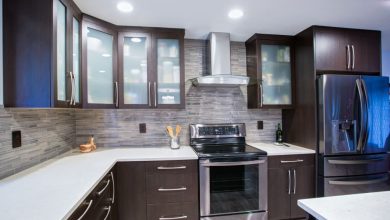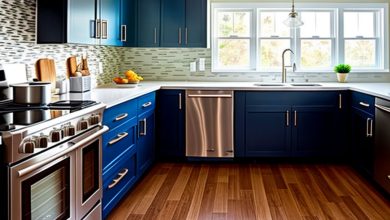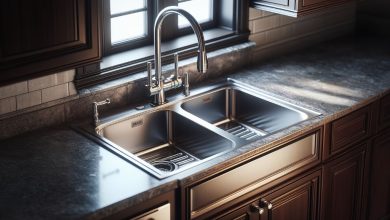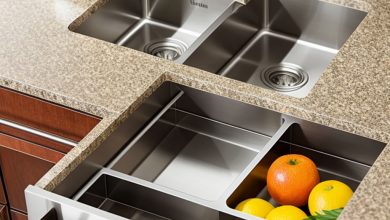How Much to Install Kitchen Cabinets: A Budgeting Guide
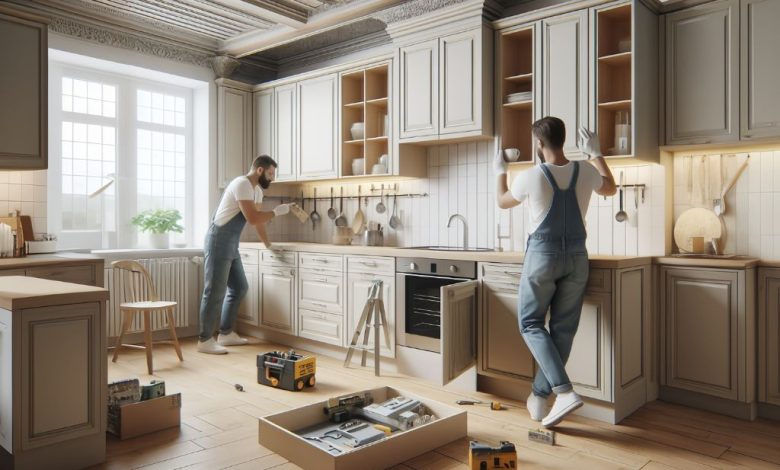
Are you pondering how much to install kitchen cabinets? Renovating your kitchen can breathe new life into your home, enhancing both its functionality and aesthetic appeal. However, it’s crucial to budget wisely to achieve the desired outcome without breaking the bank.
When it comes to kitchen renovations, careful planning is key. From selecting the right materials to hiring professionals for installation, every decision impacts the overall cost. By understanding the various factors involved, you can create a realistic budget that aligns with your goals and financial resources.
Embarking on a kitchen renovation project can be exciting yet daunting. With so many options available, it’s easy to feel overwhelmed. However, with proper guidance and research, you can navigate the process confidently and achieve the kitchen of your dreams without overspending.
Understanding the importance of kitchen cabinets in home value
The kitchen is often considered the heart of the home, and the cabinets play a crucial role in its functionality and aesthetic appeal. Installing kitchen cabinets that are both stylish and functional can significantly enhance the value of your property.
Kitchen cabinets are not just storage solutions; they also contribute to the overall design and atmosphere of the space. Whether you prefer a modern, minimalist look or a more traditional aesthetic, choosing the right cabinets can transform your kitchen into a visually stunning and highly functional area.
Investing in high-quality kitchen cabinets is a smart decision for homeowners looking to increase their property value. Potential buyers are likely to be impressed by a well-designed and organized kitchen, making it easier to sell your home at a competitive price in the future.
The impact of kitchen renovations on overall property appeal
When it comes to increasing the appeal of your property, kitchen renovations can have a significant impact. Installing new kitchen cabinets can instantly refresh the look of your home, making it more attractive to potential buyers and increasing its resale value.
A modern and well-designed kitchen is a major selling point for many homebuyers. By investing in quality cabinets and other upgrades, you can make your property stand out in a competitive real estate market, attracting more interest from prospective buyers and potentially fetching a higher sale price.
Renovating your kitchen can also improve the functionality and livability of your home, making it a more enjoyable space for you and your family to spend time in. From increasing storage capacity to enhancing workflow and efficiency, the right cabinets can make a world of difference in how you use and enjoy your kitchen.
Types of Kitchen Cabinets
When it comes to installing kitchen cabinets, there are several options to choose from, each offering its own unique advantages and considerations. Understanding the differences between these types of cabinets can help you make an informed decision that meets your needs and budget.
Stock cabinets: Affordable and readily available
Stock cabinets are pre-made and mass-produced, making them an affordable option for homeowners on a budget. These cabinets are available in standard sizes and designs, making them easy to find and install without the need for customization.
Despite their lower cost, stock cabinets are often made from high-quality materials and offer a range of finishes and styles to choose from. While they may lack some of the customization options of semi-custom or custom cabinets, stock cabinets can still provide a stylish and functional storage solution for your kitchen.
One of the main advantages of stock cabinets is their affordability and availability. Since they are mass-produced, stock cabinets are typically readily available at home improvement stores and can be installed relatively quickly, making them an ideal choice for homeowners looking to complete their kitchen renovation on a tight timeline or budget.
Semi-custom cabinets: Balancing customization and cost
Semi-custom cabinets offer a middle ground between stock and custom options, allowing for some degree of customization while still being more affordable than fully custom cabinets. These cabinets are built to order, allowing you to choose from a variety of sizes, styles, and finishes to suit your preferences.
One of the key benefits of semi-custom cabinets is their flexibility. While they may not offer the same level of customization as fully custom cabinets, semi-custom options still allow you to tailor certain aspects of the design to better meet your needs and preferences.
Another advantage of semi-custom cabinets is their higher quality construction compared to stock options. Since they are built to order, semi-custom cabinets are typically made from durable materials and offer more options for features such as soft-close hinges and dovetail joints, ensuring a long-lasting and functional storage solution for your kitchen.
Custom cabinets: Tailored to your unique needs
Custom cabinets offer the ultimate in flexibility and customization, allowing you to create a truly one-of-a-kind storage solution for your kitchen. These cabinets are built to your exact specifications, ensuring a perfect fit and maximizing every inch of available space.
One of the main advantages of custom cabinets is their ability to be tailored to your unique needs and preferences. Whether you have specific storage requirements, design preferences, or space constraints, custom cabinets can be designed to accommodate them, allowing you to create a kitchen that is both highly functional and visually stunning.
In addition to their customizability, custom cabinets are also known for their superior craftsmanship and quality. Since they are built by skilled craftsmen using high-quality materials, custom cabinets are built to last and can withstand the rigors of daily use, making them a wise long-term investment for your home.
Factors Affecting Installation Costs
Planning your kitchen renovation involves considering various factors that can influence how much to install kitchen cabinets. Understanding these factors will help you create an accurate budget and ensure a successful project outcome.
Linear footage: Calculating the total cabinet length
Determining the linear footage of your cabinets is a crucial step in estimating installation costs. Measure the length of each wall where cabinets will be installed, including any corners or alcoves. This measurement will help you calculate the total linear footage and provide an accurate estimate for materials and labor.
When calculating linear footage, it’s essential to account for any special features or design elements that may affect the layout of your cabinets. For example, angled walls, bay windows, or built-in appliances may require custom cabinet configurations, resulting in additional costs.
Consider consulting with a professional contractor or kitchen designer to ensure accurate measurements and a thorough understanding of your project’s requirements. They can help you identify any potential challenges or considerations that may impact installation costs and provide expert guidance on optimizing your kitchen layout for efficiency and functionality.
Material quality: From particleboard to solid wood
The quality of materials used for your kitchen cabinets significantly impacts installation costs and long-term durability. When choosing materials, consider factors such as particleboard, MDF, plywood, or solid wood construction.
- Particleboard is a cost-effective option commonly used for budget-friendly cabinets. However, it is less durable than other materials and may not withstand moisture or heavy use as well.
- MDF (Medium-Density Fiberboard) is another affordable option known for its smooth finish and versatility. While more durable than particleboard, MDF may still be susceptible to moisture damage over time.
- Plywood offers greater strength and durability compared to particleboard and MDF. It consists of multiple layers of wood veneers glued together, making it more resistant to warping, cracking, and moisture.
- Solid wood cabinets are the highest quality option, offering superior durability, beauty, and longevity. While more expensive than engineered wood alternatives, solid wood cabinets provide timeless elegance and can last for decades with proper care.
When considering material quality, weigh the upfront cost against long-term value and durability. Investing in higher-quality materials may require a larger initial investment but can ultimately save you money by reducing the need for repairs or replacements in the future.
Design complexity: Intricate details and features
The complexity of your cabinet design can significantly impact installation costs. Cabinets with intricate details, such as ornate moldings, decorative panels, or specialty finishes, require more time and labor to install properly.
Customization options, such as pull-out drawers, lazy Susans, or built-in organizers, also add to the complexity of the installation process. While these features enhance functionality and storage capacity, they may incur additional costs due to their intricate design and customization requirements.
When designing your kitchen cabinets, balance aesthetics with practicality and budget considerations. Focus on incorporating features that enhance usability and reflect your personal style without compromising on quality or affordability.
Labor charges: Professional installation costs
Hiring a professional contractor for cabinet installation ensures a high-quality finish and proper functionality. Labor charges for professional installation typically include the cost of skilled labor, tools, equipment, and overhead expenses.
The complexity of your project, as well as local labor rates and contractor availability, will influence labor costs. Factors such as cabinet size, layout, and design complexity may require more time and expertise, resulting in higher labor charges.
When budgeting for labor costs, obtain multiple quotes from reputable contractors and compare prices and services. Choose a contractor with a proven track record of quality workmanship and customer satisfaction, even if their rates may be slightly higher.
Average Cost Breakdown
Understanding the average cost breakdown of different types of cabinets will give you a clearer idea of how much to install kitchen cabinets and help you plan your budget accordingly.
Stock cabinets: $100 to $400 per linear foot
Stock cabinets are prefabricated and mass-produced, making them the most affordable option for homeowners. Prices for stock cabinets typically range from $100 to $400 per linear foot, depending on factors such as material quality, design, and brand.
Despite their lower cost, stock cabinets offer limited customization options and may not fit every kitchen layout perfectly. However, they provide a cost-effective solution for basic storage needs and can be a suitable choice for budget-conscious homeowners.
Semi-custom cabinets: $150 to $700 per linear foot
Semi-custom cabinets offer a balance between affordability and customization. Prices for semi-custom cabinets range from $150 to $700 per linear foot, depending on factors such as material quality, design complexity, and additional features.
Semi-custom cabinets allow for more flexibility in design and layout compared to stock cabinets, with options for custom sizes, finishes, and hardware. While more expensive than stock cabinets, semi-custom options offer greater versatility and personalization for your kitchen.
Custom cabinets: $500 to $1,200 per linear foot
Custom cabinets are fully customized to your specifications, offering the ultimate in design flexibility and craftsmanship. Prices for custom cabinets range from $500 to $1,200 per linear foot or more, depending on factors such as material quality, design complexity, and artisanal craftsmanship.
While custom cabinets are the most expensive option, they provide unparalleled quality, customization, and durability. Custom cabinets are built to fit your kitchen precisely, maximizing space and functionality while reflecting your unique style and preferences.
Note: Prices for kitchen cabinets may vary depending on factors such as location, supplier, brand, and any additional features or accessories included.
Additional Expenses
In addition to the cost of installing kitchen cabinets, there are several other expenses you should budget for to ensure a smooth and successful renovation project.
Hardware and accessories: Handles, knobs, and hinges
- Handles and Knobs: These small details can make a big impact on the overall look and functionality of your cabinets. Choose handles and knobs that complement your cabinet style and suit your personal taste.
- Hinges: Selecting high-quality hinges is essential for ensuring smooth operation and longevity of your cabinet doors. Consider options such as soft-close hinges for added convenience and noise reduction.
- Cost Considerations: Factor in the cost of hardware and accessories when budgeting for your kitchen renovation. While these items may seem minor, they can add up quickly and significantly impact your overall expenses.
Trim and molding: Enhancing aesthetics
- Crown Molding: Adding crown molding to your cabinets can create a polished and cohesive look, elevating the overall aesthetic appeal of your kitchen.
- Baseboards: Installing baseboards along the bottom of your cabinets helps conceal gaps and provides a finished appearance.
- Decorative Trim: Consider incorporating decorative trim and molding details to enhance the visual interest of your cabinets and tie together the design elements of your kitchen.
Delivery and installation fees
- Delivery Costs: Depending on the supplier or manufacturer, you may incur delivery fees for transporting your cabinets to your home. Be sure to factor these costs into your budget to avoid any surprises.
- Installation Charges: If you’re hiring professionals for cabinet installation, be prepared for installation fees. These charges typically include labor costs for assembling and installing the cabinets, as well as any additional services such as leveling and adjustment.
- Budget Considerations: When budgeting for delivery and installation fees, obtain quotes from multiple suppliers and contractors to compare prices and services. Be sure to inquire about any additional charges or fees that may apply to your specific project.
Real-Life Example
Examining a real-life example of a kitchen cabinet installation can provide valuable insights into the costs involved and help you better understand how much to install kitchen cabinets.
Case study: Semi-custom kitchen installation in Prescott, Arizona
In this case study, we’ll explore the costs associated with a semi-custom kitchen cabinet installation in Prescott, Arizona.
- Cabinet specifications and design choices:
- The homeowner opted for semi-custom cabinets with maple wood construction and a shaker-style design.
- Additional features included soft-close hinges, pull-out drawers, and a built-in pantry for added storage.
- Labor, materials, and hardware costs:
- Professional installation by a licensed contractor accounted for the majority of the labor costs.
- Materials, including the cabinets, hardware, trim, and molding, were sourced from a local supplier.
- Hardware costs included brushed nickel handles and knobs for a modern look.
- Total project expenses:
- The total cost of the semi-custom kitchen cabinet installation, including labor, materials, and hardware, amounted to approximately $15,000.
- This figure reflects the average cost for a mid-range kitchen renovation in the Prescott area, taking into account the specific design choices and features selected by the homeowner.
Budgeting Tips
Managing your budget effectively is crucial when planning for a kitchen cabinet installation. Consider these tips to help you stay within your budget while achieving the kitchen of your dreams.
Prioritizing essential features
- Functionality: Focus on essential features that enhance the functionality of your kitchen. Allocate your budget towards elements such as adequate storage space, efficient layout design, and durable materials.
- Quality: Invest in high-quality materials and craftsmanship for your cabinets. Quality construction ensures longevity and durability, reducing the likelihood of costly repairs or replacements in the future.
- Aesthetics: Strike a balance between aesthetics and budget by prioritizing design elements that have the most significant impact on the overall look of your kitchen. Choose timeless styles and finishes that will remain stylish for years to come.
Exploring cost-saving alternatives
- Ready-to-Assemble (RTA) Cabinets: Consider ready-to-assemble cabinets as a cost-effective alternative to custom or semi-custom options. RTA cabinets are pre-fabricated and easy to install, making them an attractive choice for budget-conscious homeowners.
- Refacing: If your existing cabinets are structurally sound but outdated, consider refacing them instead of replacing them entirely. Refacing involves applying a new veneer or laminate to the existing cabinet boxes and replacing doors, drawers, and hardware for a fresh new look.
- Open Shelving: Explore the option of open shelving as a budget-friendly alternative to traditional cabinets. Open shelving can create a light and airy feel in your kitchen, while also providing convenient storage for frequently used items.
Obtaining multiple quotes from contractors
- Research: Take the time to research and gather quotes from multiple contractors before making a decision. Be sure to compare prices, services, and warranties to ensure you’re getting the best value for your money.
- References: Ask for references and check online reviews to gauge the reputation and reliability of potential contractors. A reputable contractor with a proven track record of quality workmanship and customer satisfaction is worth the investment.
- Communication: Clear communication is key when working with contractors. Be upfront about your budget and expectations, and ask questions about any aspects of the project that are unclear. A good contractor will listen to your needs and provide solutions that align with your budget and vision.
Hidden Costs to Consider
In addition to the upfront expenses, there are several hidden costs to consider when budgeting for your kitchen cabinet installation.
Removal and disposal of old cabinets
- Demolition: Budget for the cost of removing your existing cabinets, including labor, tools, and disposal fees. Depending on the size and condition of your cabinets, demolition costs can vary.
- Disposal: Factor in the cost of disposing of your old cabinets responsibly. This may involve renting a dumpster or hiring a waste removal service to haul away debris and materials.
Structural modifications (if needed)
- Structural Changes: If your kitchen requires structural modifications to accommodate new cabinets, such as removing walls or relocating plumbing and electrical outlets, be prepared for additional costs. Consult with a contractor to assess the scope of work and budget accordingly for any necessary changes.
- Permits: Depending on the extent of the structural modifications, you may need to obtain permits from your local building department. Permit fees and inspection costs should be included in your overall budget to ensure compliance with building codes and regulations.
Unexpected repairs during installation
- Unforeseen Issues: During the installation process, unforeseen issues may arise that require additional repairs or adjustments. Budget for contingencies to cover unexpected expenses, such as repairing damaged walls, flooring, or plumbing fixtures.
- Contingency Fund: Set aside a contingency fund to address any unexpected repairs or changes that may arise during the renovation process. Having extra funds available will provide peace of mind and help prevent budget overruns.
DIY vs. Professional Installation
Deciding between DIY and professional installation for your kitchen cabinets is a crucial decision that can impact the outcome of your renovation project. Consider the following factors to determine the best approach for your needs.
Pros and cons of each approach
DIY Installation:
- Pros:
- Cost-saving potential by eliminating labor expenses.
- Greater control over the installation process and timeline.
- Sense of accomplishment and satisfaction from completing the project yourself.
- Cons:
- Requires time, effort, and DIY skills.
- Risk of errors or mistakes that could compromise the quality and functionality of the cabinets.
- Limited access to professional expertise and resources.
Professional Installation:
- Pros:
- Expertise and experience ensure a high-quality installation.
- Saves time and hassle by delegating the work to skilled professionals.
- Guarantees proper alignment, fit, and functionality of the cabinets.
- Cons:
- Higher upfront cost due to labor expenses.
- Dependence on the availability and schedule of professional contractors.
- Less hands-on involvement in the installation process.
Assessing your skills and resources
Before deciding on DIY or professional installation, assess your skills, experience, and available resources. Consider factors such as your level of proficiency in carpentry, familiarity with power tools, and ability to follow complex instructions. Additionally, evaluate the time and effort you can dedicate to the project.
Ensuring safety and quality
Whether you choose DIY or professional installation, prioritize safety and quality throughout the process. Follow proper safety protocols when handling tools and materials, and ensure that all installations comply with building codes and regulations. Invest in high-quality materials and craftsmanship to achieve durable and long-lasting results.
Maximizing Value
When it comes to installing kitchen cabinets, maximizing the value of your investment is essential. Consider the following strategies to ensure that you get the most bang for your buck:
Choosing timeless designs
- Classic Styles: Opt for kitchen cabinet designs that stand the test of time. Classic styles such as Shaker or raised-panel cabinets have enduring appeal and can enhance the resale value of your home.
- Neutral Finishes: Choose neutral finishes like white, gray, or wood tones that are versatile and adaptable to changing design trends. Avoid trendy colors or finishes that may quickly go out of style.
- Versatile Hardware: Select hardware and accessories that complement your cabinet design while offering flexibility for future updates. Simple, understated hardware in finishes like brushed nickel or matte black is timeless and versatile.
Opting for durable materials
- Quality Construction: Invest in cabinets made from durable materials such as solid wood or plywood. Quality construction ensures longevity and resistance to wear and tear, reducing the need for frequent replacements or repairs.
- High-Quality Finishes: Choose finishes that are not only aesthetically pleasing but also durable and easy to maintain. Look for options like stain-resistant paints or finishes that offer protection against scratches, moisture, and UV damage.
- Sustainable Materials: Consider eco-friendly options such as bamboo or reclaimed wood for your cabinets. Sustainable materials not only reduce environmental impact but also offer durability and longevity, making them a worthwhile investment in the long run.
Proper maintenance and care
- Regular Cleaning: Implement a regular cleaning routine to keep your cabinets looking their best. Use mild soap and water to wipe down cabinet surfaces, avoiding harsh chemicals or abrasive cleaners that can damage finishes.
- Preventive Maintenance: Address minor issues promptly to prevent them from escalating into larger problems. Tighten loose hardware, repair minor scratches or dents, and touch up any areas of damage to maintain the integrity and appearance of your cabinets.
- Seasonal Maintenance: Perform seasonal maintenance tasks such as lubricating hinges, adjusting drawer slides, and inspecting for signs of water damage or pests. Taking proactive measures to address maintenance issues can prolong the lifespan of your cabinets and minimize the need for costly repairs.
Conclusion
In conclusion, installing kitchen cabinets is not just an expense but an investment in your home’s value and functionality. By prioritizing timeless designs, durable materials, and proper maintenance, you can maximize the value of your investment and enjoy beautiful, functional cabinets for years to come.
Making informed decisions based on your budget and priorities is key to achieving a successful kitchen renovation. By carefully considering factors such as design, materials, and maintenance, you can create a space that not only meets your needs but also adds value to your home.
Whether you’re remodeling your kitchen for resale or personal enjoyment, investing in quality cabinets and thoughtful design choices will pay off in the long run. With careful planning and attention to detail, you can create a kitchen that is both stylish and functional, enhancing the overall appeal and value of your home.

